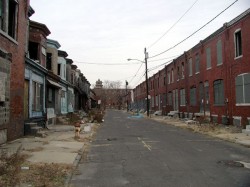 Barack Obama has declared that “immigration reform is an economic imperative“, and is promising to do his best to get an immigration bill pushed through Congress this year. But will “legalizing” all of the illegal immigration that has taken place over the last several decades improve the struggling U.S. economy or will it actually make our economic problems worse? One of the favorite tricks of top politicians is to promise that the economy is going to improve if we just support what it is that they are currently pushing. Hopefully the Americans people will not buy the nonsense that Obama is spewing. The truth is that Barack Obama is wrong about the economic impact of illegal immigration. Illegal immigrants don’t do jobs that Americans “don’t want” to do. A million Americans recently showed up to apply for a job at McDonald’s. That is how desperate Americans are for work these days. Please don’t try to tell me that there aren’t millions of Americans out there that would not pick fruit for minimum wage. The millions upon millions of illegal immigrants in this country are stealing jobs, they are depressing wages in a whole host of industries and they are a huge factor in the erosion of the middle class. Millions of middle class American families can’t afford to provide for their families anymore and are losing their homes, drowning in debt or going bankrupt. Rather than what Barack Obama is proposing (which is to essentially “legalize” illegal immigration), we need an immigration policy that makes sense and that protects American jobs.
Barack Obama has declared that “immigration reform is an economic imperative“, and is promising to do his best to get an immigration bill pushed through Congress this year. But will “legalizing” all of the illegal immigration that has taken place over the last several decades improve the struggling U.S. economy or will it actually make our economic problems worse? One of the favorite tricks of top politicians is to promise that the economy is going to improve if we just support what it is that they are currently pushing. Hopefully the Americans people will not buy the nonsense that Obama is spewing. The truth is that Barack Obama is wrong about the economic impact of illegal immigration. Illegal immigrants don’t do jobs that Americans “don’t want” to do. A million Americans recently showed up to apply for a job at McDonald’s. That is how desperate Americans are for work these days. Please don’t try to tell me that there aren’t millions of Americans out there that would not pick fruit for minimum wage. The millions upon millions of illegal immigrants in this country are stealing jobs, they are depressing wages in a whole host of industries and they are a huge factor in the erosion of the middle class. Millions of middle class American families can’t afford to provide for their families anymore and are losing their homes, drowning in debt or going bankrupt. Rather than what Barack Obama is proposing (which is to essentially “legalize” illegal immigration), we need an immigration policy that makes sense and that protects American jobs.
Before we go any further, it is important for me to make a few points. It is not a bad thing that people want to come to this nation from another country. A lot of people that want to come to the United States are really hard working and have really solid character. This nation has a long tradition of immigrants arriving to build a better life here. At different times this country will need different levels of immigration, but we will always need new immigrants. People on one side of a border are not more “valuable” than people on another side of a border. There is a reason why our founding fathers believed that “all men are created equal”. In every nation on earth there are really wonderful people. We should love all men, women and children no matter where they were born and no matter what they look like. God created us all and He loves us all dearly.
The reason I went into all that is because of the way politics is played in America in 2011. The moment that anyone suggests that there might be a problem with illegal immigration they are immediately branded with all kinds of horrible labels. To put a horrible label on someone that is completely and totally untrue just to score political points is absolutely despicable.
The funny thing is that some of the organizations that denounce others the loudest should actually be examining themselves. For example, one of the largest pro-illegal immigration organizations is called “La Raza”, which literally means “The Race” (as if we all couldn’t figure it out). Perhaps it is time for them to come up with a new name.
Look, we all have to start learning to love each other. If not, our society is going to continue to break down.
A majority of the American people (yes, that is what the polls show) are not against illegal immigration because they “hate” another group of people. Rather, they just want all immigrants to go through the “front door” and they want the government to be sensitive to changing economic conditions.
The sad truth is that the U.S. government has absolutely refused to secure the U.S. border with Mexico for decades, and this has allowed millions upon millions of criminals, drug dealers and gang members to cross freely into the United States. In addition, by refusing to secure the border we have allowed new diseases to spread unchecked into this country.
Meanwhile, the law abiding people that would like to get into this country legally are put through absolute hell. I used to practice law and I have filled out immigration forms. The process is a complete and total nightmare.
So we have been making it really easy for law breakers to sneak in the back door of our country and we have been making it really hard for law abiding people to get in the front door.
What in the world could be wrong about wanting to fix that?
Once many illegal immigrants arrive in the United States they either try to make a living legally (by directly competing with blue collar American workers for jobs and driving their wages down) or illegally by selling drugs or being involved in other kinds of criminal activity.
Apparently Barack Obama believes that this kind of behavior should be rewarded with a “path to citizenship”.
The vast majority of illegal immigrants pay absolutely no federal or state income taxes and they never intend to. At the same time, they seem more than happy to take advantage of the free social services and benefits offered to them. In fact, stories of how “good” life in America is just encourages more and more immigrants to come to the United States illegally.
We need an immigration policy that insists that everyone come in through the front door.
Is there anyone out there that cannot agree with that?
We also need to set immigration levels that our economy can handle.
Right now our economy is struggling. Millions upon millions of Americans are out of work. 44 million Americans are on food stamps. 47 million Americans are living in poverty. We just can’t take in a whole lot of extra workers right now.
You would think that would just be common sense.
But instead, Barack Obama wants to grant amnesty to all of the illegal immigrants that are already here and put them on a path to citizenship.
Wow – do you think that might embolden millions more illegal immigrants to come flooding in?
Barack Obama is against a border fence. He says we don’t need it.
Meanwhile, thousands more illegal immigrants pour into this country every single day.
Barack Obama supports all of the “sanctuary cities” that have openly declared that they are not going to enforce our immigration laws.
So where do you think illegal immigrants are going to flock to? The truth is that word about these “sanctuary cities” gets around really fast. If you live in one of these cities, then you probably know all about it.
If Barack Obama gets his way, nobody will be breaking our immigration laws because essentially there will not be any more immigration laws.
Not that George W. Bush was any better. He was an absolute disaster on immigration as well.
The truth is that our immigration policy has been slowly eroding the U.S. middle class for many decades.
But according to Barack Obama, we desperately need to implement his “immigration reform” plan for the good of the middle class….
“One way to strengthen the middle class in America is to reform the immigration system, so that there is no longer a massive underground economy that exploits a cheap source of labor while depressing wages for everybody else.”
What a joke. The reality is that illegal immigration hurts that U.S. middle class and it is severely damaging to the U.S. economy. Because of illegal immigration, every single day wages are lost, taxes don’t get collected, hospitals provide “free health care” for which they are never paid, huge criminal gangs of foreigners are roaming our streets and the cost of providing social services to illegal aliens is slowly bankrupting state and local governments.
The following are 18 facts which prove that illegal immigration is an absolute nightmare for the U.S. economy….
#1 Illegal immigrants take jobs away from American citizens. According to a review of U.S. Bureau of Labor Statistics and Census Bureau data, legal and illegal immigrants gained over a million additional jobs between 2008 and 2010 even as millions of American citizens were losing their jobs during that same time period.
#2 The majority of our immigrants now sneak in through the “back door” that the federal government purposely leaves open. Thanks to the negligence of the federal government, far more people move into the United States illegally than come in through the legal immigration process. This has got to change.
#3 Illegal immigrants generally don’t pay taxes. The vast majority of illegal aliens would never even dream of paying income taxes, but Mexicans living in America send billions upon billions of dollars out of the United States and back to Mexico every single year.
#4 Although illegal aliens pay next to nothing in taxes, they have no problem receiving tens of billions of dollars worth of free education benefits, free health care benefits, free housing assistance and free food stamp benefits. Many communities in the United States now openly advertise that they will help illegal aliens with these things.
#5 The cost of educating the children of illegal immigrants is staggering. It is estimated that U.S. taxpayers spend $12,000,000,000 a year on primary and secondary school education for the children of illegal immigrants.
#6 Thanks to illegal immigration, California’s overstretched health care system is on the verge of collapse. Dozens of California hospitals and emergency rooms have shut down over the last decade because they could not afford to stay open after being endlessly swamped by illegal immigrants who were simply not able to pay for the services that they were receiving. As a result, the remainder of the health care system in the state of California is now beyond overloaded. This had led to brutally long waits, diverted ambulances and even unnecessary patient deaths. Sadly, the state of California now ranks dead last out of all 50 states in the number of emergency rooms per million people.
#7 It was estimated that there were approximately 7.7 million illegal aliens employed by U.S. employers during 2008. How much better would our economy look if all of those jobs were being filled by American workers?
#8 The region along the U.S./Mexico border is now an open war zone. Just across the U.S. border, the city of Juarez, Mexico is considered to be one of the most dangerous cities on the entire planet because of the brutal drug war being waged there. In fact, Juarez has now become the murder capital of the western hemisphere. Much of that violence has begun to spill over into areas of the southwestern United States.
For example, a while back NPR described one incident in the Juarez Valley that involved American citizens….
A couple of weeks ago, gunmen in the Juarez Valley killed the Mexican relative of a Fort Hancock high school student. When the student’s family in Fort Hancock heard about it, they crossed the border at 10 a.m. to see the body, and took the student with them.
“By 10:30, they had stabbed the relatives that went with him, which included his grandparents, with an ice pick,” says school superintendent Jose Franco. “My understanding is that the gentleman is like 90 years old, and they poked his eyes out with an ice pick. I believe those people are still in intensive care here in a hospital in the U.S.”
#9 A substantial percentage of young illegal immigrants end up in gangs. U.S. authorities say that there are now over 1 million members of criminal gangs operating inside the United States. According to federal statistics, these 1 million gang members are responsible for up to 80% of the violent crimes committed in the U.S. each year. Latino gangs made up primarily of illegal aliens are responsible for much of this violence.
According to the Center for Immigration Studies, some of the most notorious gangs in the country are made up almost entirely of illegal immigrants….
“Gang investigators in Virginia estimate that 90% of the members of MS-13, the most notorious immigrant gang, are illegal immigrants.”
#10 The “18th Street Gang” is certainly giving MS-13 a run for their money. It is believed that the 18th Street Gang has thousands of members in the city of Los Angeles alone. In fact, the gang has become so notorious that there are even rumors that some police officers in Los Angeles simply will not venture into the areas most heavily controlled by the 18th Street gang.
The following is what Wikipedia says about the 18th Street Gang….
A US Justice Department report from 2009 estimates that the 18th Street gang has a membership of some 30,000 to 50,000 with 80% of them being illegal aliens from Mexico and Central America and is active in 44 cities in 20 states. Its main source of income is street-level distribution of cocaine and marijuana and, to a lesser extent, heroin and methamphetamine. Gang members also commit assault, auto theft, carjacking, drive-by shootings, extortion, homicide, identification fraud, and robbery.
#11 The “drug war” in northern Mexico is one gigantic bloodbath. The Mexican government says that as many as 28,000 people have been slaughtered by the drug cartels since 2007. A very significant percentage of those deaths have happened in areas right along the U.S. border, and yet our federal government still sees no reason to get serious about border security.
#12 It is an open secret that Mexican drug cartels are openly conducting military operations inside the United States. The handful of border patrol agents that we have guarding the border are massively outgunned and outmanned.
One agent who patrols the border and who asked to remain anonymous told Fox News the following….
“To say that this area is out of control is an understatement.”
A different federal agent put it this way in an email to Fox News….
“Every night we’re getting beaten like a pinata at a birthday party by drug, alien smugglers.”
#13 Federal border officials say that Mexican drug cartels have not only set up shop on U.S. soil, but they are actually maintaining lookout bases in strategic locations in the hills of southern Arizona. If you go to Arizona today, there are actually signs that have been put up by the federal government warning American citizens not to venture into certain wilderness routes that are used by Mexican drug cartels to bring in drugs.
#14 The drug war being waged on both sides of the border is so violent that it is almost unimaginable. For example, one very prominent Mexican assassin known as “the soupmaker” has confessed that he made approximately 300 bodies disappear by dissolving them in acid baths. But right now there is essentially nothing that is preventing the next “soupmaker” from crossing the U.S. border and moving into your neighborhood.
#15 Arizona police are being openly warned by the Mexican drug cartels that if they try to interfere with the drug traffic in their area that they will be “taken out” by drug cartel snipers.
#16 While the U.S. military endlessly hunts for “members of al-Qaeda” in the caves of Afghanistan and on the streets of Iraqi cities, a very real threat has been building just south of the border. Over the past 15 to 20 years, Hezbollah has set up operations all over Mexico, Central America and South America. Hezbollah is reportedly making a lot of money in the drug trade and in trafficking illegal aliens. Sadly, our government is largely ignoring this.
#17 Each year, it costs the states billions of dollars to incarcerate illegal immigrant criminals that should have never been allowed into the country in the first place. It is estimated that illegal aliens make up approximately 30 percent of the population in federal, state and local prisons and that the total cost of incarcerating them is more than $1.6 billion annually.
#18 The drug cartels and the gangs always seem to be a couple steps ahead of our agents along the border. Approximately 75 tunnels along the U.S. border with Mexico have been discovered by law enforcement authorities in the last four years alone.
How much do you think all of this crime, gang violence and drug cartel activity is costing our economy?
Why won’t the federal government do what the Constitution requires and secure the border?
Oh, but Barack Obama says that he has a plan.
He says that he is going to save the day.
The following is how Barack Obama describes his plan…
“We are not going to ship back 12 million people, we’re not going to do it as a practical matter. We would have to take all our law enforcement that we have available and we would have to use it and put people on buses, and rip families apart, and that’s not who we are, that’s not what America is about. So what I’ve proposed… is you say we’re going to bring these folks out of the shadows. We’re going to make them pay a fine, they are going to have to learn English, they are going to have to go to the back of the line…but they will have a pathway to citizenship over the course of 10 years.”
So how many illegal immigrants do you think are going to step forward to pay a fine?
One percent?
How many of them do you think are going to show up for English classes?
Who is going to make them do it?
Obama?
Are we going to have law enforcement officials running around trying to collect fines from illegal immigrants and trying to get them to attend their English lessons?
According to Obama, the millions upon millions of illegal immigrants that are in this country are going to be glad to willingly do the following….
1) Admit they broke the law
2) Pay back taxes and a fine
3) Learn English
4) Be willing to undergo background checks before starting the legalization process
Those four points are taken directly from Obama’s plan.
So what are illegal immigrants going to do when this plan is passed?
99 percent of them are going to laugh and they are just going to keep on doing what they have been doing.
Large numbers of illegal immigrants are already enjoying the “high life” in the dozens of “sanctuary cities” across the United States.
The following is how the Ohio Jobs & Justice PAC defines sanctuary cities….
Generally, sanctuary policies instruct city employees not to notify the federal government of the presence of illegal aliens living in their communities. The policies also end the distinction between legal resident aliens and illegal aliens–so illegal aliens often benefit from taxpayer funded government services and programs too.
Sounds like a good deal to me.
Can I sign up for that plan?
After all, who wouldn’t want to earn all income tax-free and yet enjoy unlimited government services?
Today we are being told that we need to make life as comfortable as possible for the waves of illegal immigrants that are coming in. In fact, Barack Obama says that all of us need to make sure that our kids are learning how to speak Spanish….
“I don’t understand when people are going around worrying about, we need to have English only. They want to pass a law, we just, we want English only…Now, I agree that immigrants should learn English, I agree with this. But understand this, instead of worrying about whether immigrants can learn English, they’ll learn English, you need to make sure your child can speak Spanish.”
All of this is utter insanity.
The cold, hard reality of the matter is that we have tightly secured the border between South Korea and North Korea for over 50 years and we could secure our own borders if we really wanted to.
But instead, we continue to leave our border with Mexico completely wide open. Thousands of criminals, gang members and drug pushers continue to come in completely unchecked every single day.
Meanwhile, the rest of us have to subject ourselves to some of the most humiliating “security measures” imaginable before we are even allowed to get on to an airplane.
It doesn’t make a whole lot of sense, does it?
 So many economists and financial pundits seem absolutely shocked that the U.S. economy is slowing down again. It is as if this latest wave of bad economic data has caught them completely by surprise. Now, in the mainstream media we are seeing all kinds of headlines declaring that the U.S. economy is headed for disaster. But anyone with half a brain could have seen this coming. This year alone, we have seen the worst tsunami in Japanese history, the worst U.S. tornado season in recent memory and the worst Mississippi River flooding in decades. In addition, chaos in the Middle East has pushed the price of oil up to very high levels. Of course all of those things were going to have an effect on the economy. In addition, all of the long-term trends that have been destroying the U.S. economy for decades have not been taken a breather. In fact, the truth is that all of our long-term economic problems have been accelerating. So yes, the sky is falling, it is time to panic and the U.S. economy really has fallen and it really can’t get up. It is just that everyone in the mainstream media seems to have believed that Ben Bernanke and Barack Obama would just sprinkle a bunch of fairy dust on the economy and everything would just magically get better. Well, in the real world things simply do not work that way.
So many economists and financial pundits seem absolutely shocked that the U.S. economy is slowing down again. It is as if this latest wave of bad economic data has caught them completely by surprise. Now, in the mainstream media we are seeing all kinds of headlines declaring that the U.S. economy is headed for disaster. But anyone with half a brain could have seen this coming. This year alone, we have seen the worst tsunami in Japanese history, the worst U.S. tornado season in recent memory and the worst Mississippi River flooding in decades. In addition, chaos in the Middle East has pushed the price of oil up to very high levels. Of course all of those things were going to have an effect on the economy. In addition, all of the long-term trends that have been destroying the U.S. economy for decades have not been taken a breather. In fact, the truth is that all of our long-term economic problems have been accelerating. So yes, the sky is falling, it is time to panic and the U.S. economy really has fallen and it really can’t get up. It is just that everyone in the mainstream media seems to have believed that Ben Bernanke and Barack Obama would just sprinkle a bunch of fairy dust on the economy and everything would just magically get better. Well, in the real world things simply do not work that way.






